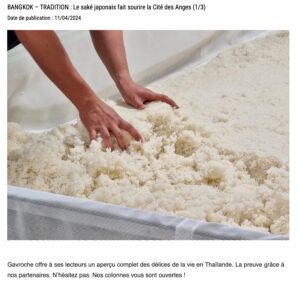Featured in French magazine GAVROCHE – Thailand!

< Translated to English below>
Gavroche offers its readers a complete overview of the delights of life in Thailand. Proof thanks to our partners. Do not hesitate. Our columns are open to you!
The sake, a Japanese alcoholic drink titling between 14 to 20% of alcohol, is made from a brewing of rice, water, yeasts and rice cooked with steam, of which approximately 20% was previously seeded By a microscopic fungus, the Koji-Kin, for better fermentation. In this first part of a chronicle in 3 -components, our partners of Bacchus Global, importers of organic French wines and Japanese spirits in Thailand, reveal the secrets of this ancestral drink.
1st part: the main ingredients
Rice, fundamental pillar
Saké production begins with close collaboration between rice farmer and the producer. Among the approximately 300 varieties of cultivated rice in Japan, only 5% of national harvests are dedicated to sake. These specific varieties are distinguished by their larger grains, rich in starch, essential for fermentation.
Water, source of purity
A constituting almost 80% of sake, water plays a crucial role in its manufacture. Saké’s breweries favor the regions renowned for the quality of their water sources, thus guaranteeing the reputation and purity of their final product.
Japan, blessed by an abundance of water throughout the year, benefits from precipitation and melting snow, especially in the north of the archipelago, where falls can reach 7 to 12 meters.
The rest …
The story of the sake with Mr. Koji Hara, sommelier and master of sake
The origins of rice culture in Japan date back to the Yayoi period, introduced by the Chinese in the north of the island of Kyushu before spreading to the whole archipelago. The mastery of rice field irrigation allowed Japanese to develop sake.
Nicknamed “La Boisson des Dieux”, the Nihonshu has always had a central place in Shintoist rituals, serving as a offering to the deities. During visits to Japanese sanctuaries, it is common to see barrels of wooden sake, called Komodaru, or sake cups placed on altars as a sign of propitiatory offering.
You can find the selection of sake of our partner Mr. Koji Hara, sommelier and master of sake at:
Nadaya
Open every day
From 11 a.m. to 8 p.m.
SUCH. 026 329 976, 082 248 4483
Thaniya Plaza 52 Silom RD., Suriyawong, Bangrak, Bangkok
Ig@nadayabkk
Fruitea
Japanese bistro & bar
Open every day
11 a.m. to 1 a.m.
Last command 0:15 am (food) / 0:30 am (drink)
SUCH. 027 661 996
DRC, Novotel Suite Bangkok, Sukhumvit 39
Ig@fruitea.bkk







